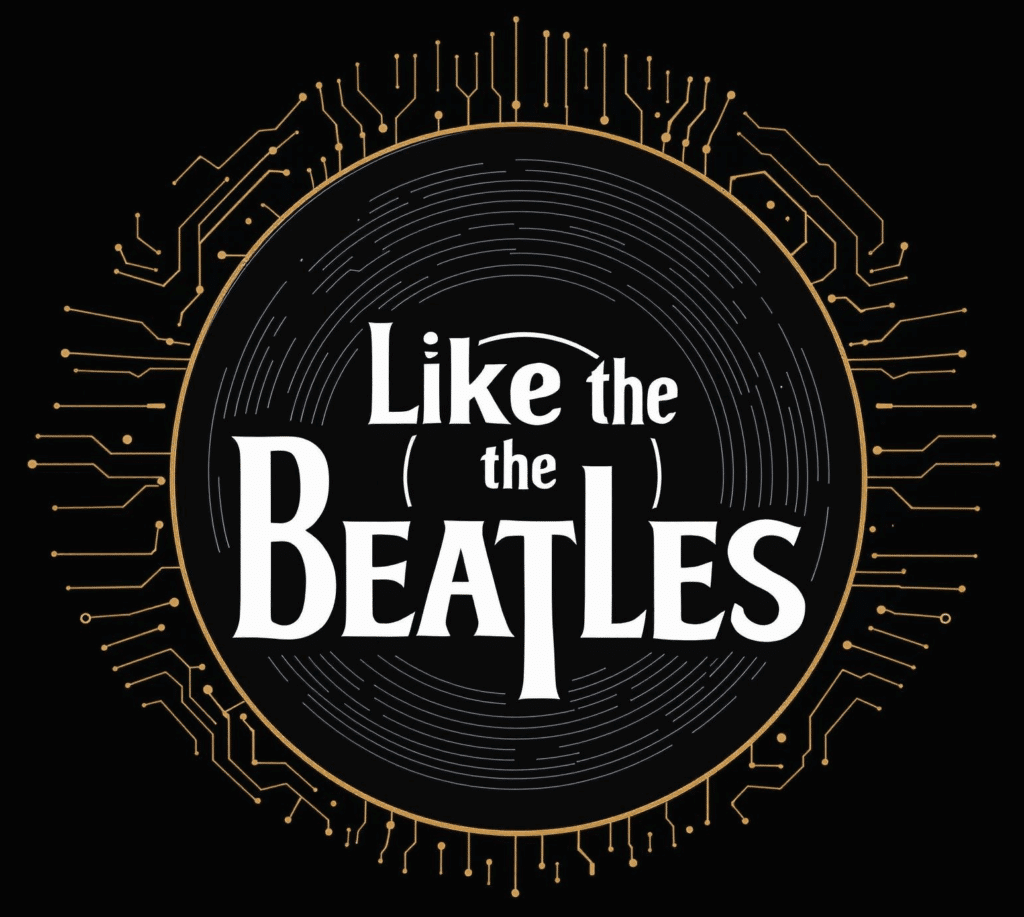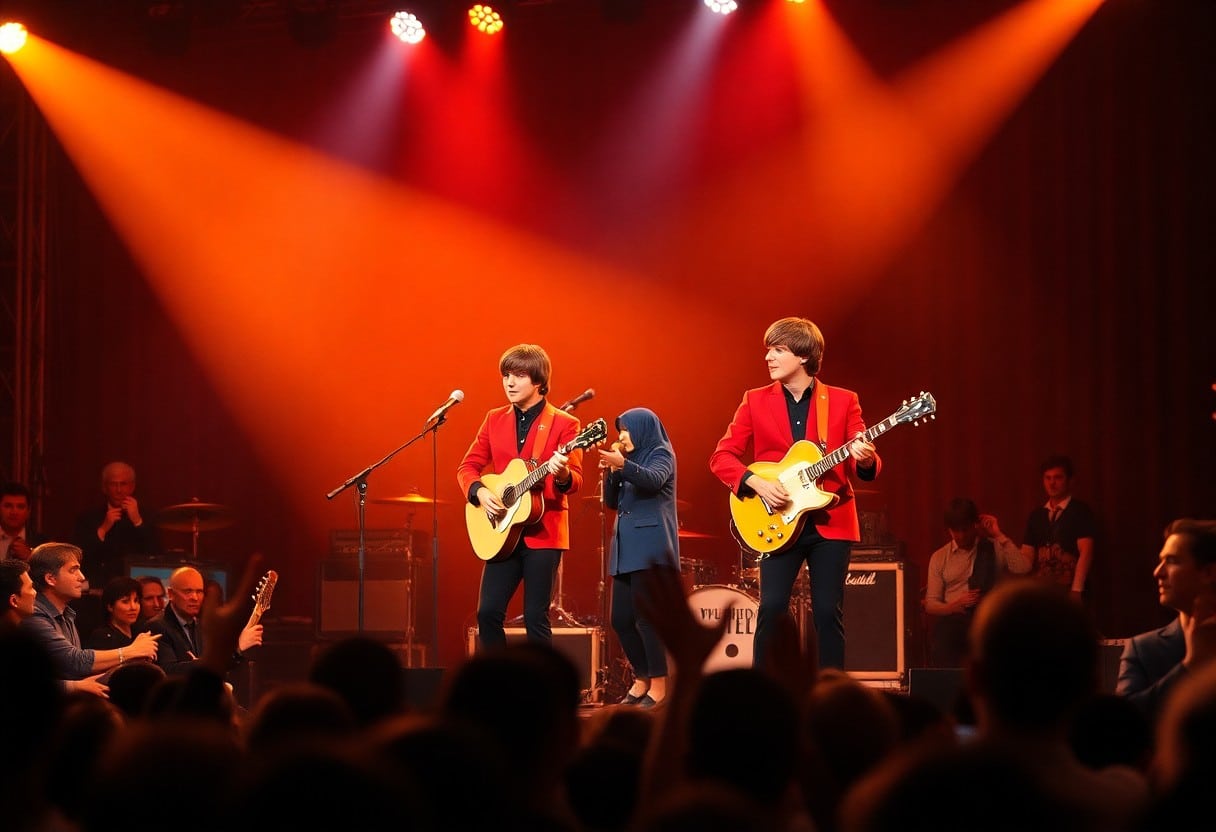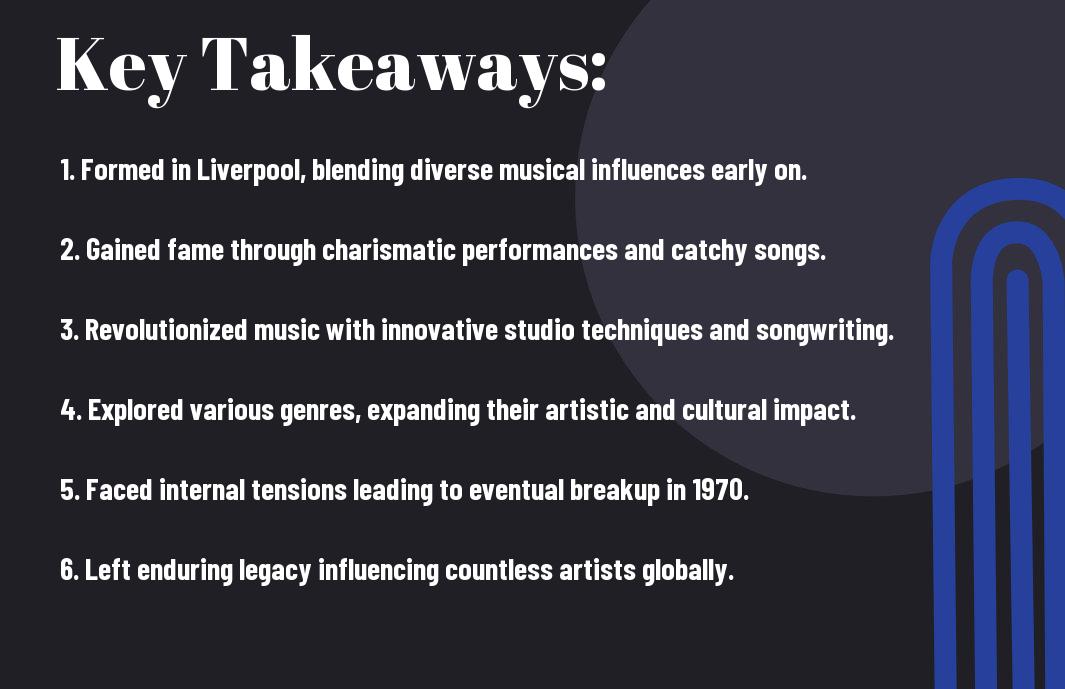With a story that spans decades and reshaped the music industry, I invite you to explore the 10 imperative steps in The Beatles’ incredible journey. In this post, I’ll take you through their beginnings in Liverpool, the challenges they faced, the groundbreaking albums that defined eras, and their ultimate impact on culture around the world. By understanding these key moments, you’ll gain a deeper appreciation for their artistry and the lasting legacy they left behind. Let’s explore the retreat and roar of the Fab Four.
The Formation of The Beatles
A fascinating journey began in the late 1950s when four young men from Liverpool intertwined their musical ambitions. John Lennon, Paul McCartney, George Harrison, and later Ringo Starr would come to symbolize an era, but it all started with a passion for music and friendship that would grow beyond their wildest dreams.
Early Years in Liverpool
At the heart of their story lies Liverpool, a bustling hub of creativity and culture. The vibrant music scene in the city, influenced by rock and roll legends, ignited their desire to play. I can feel the energy of those early days as they performed in small venues, honing their craft and forging their identities.
The Quarrymen to The Beatles
For John Lennon, the journey began with his skiffle band, The Quarrymen, which eventually evolved into The Beatles. This transformation marked a significant shift in their musical style and aspirations, as they incorporated more complex sounds and harmonies. I find it remarkable how a simple band came together, experimenting with music and cementing their place in history.
Consequently, this period saw the addition of vital members like Paul McCartney and George Harrison, enhancing the band’s musical depth. As their first lineup solidified, they began performing regularly and gained local attention. This led to them adopting the name The Beatles, a clever play on words reflecting their love for beat music. Their unique blend of harmonies and catchy melodies soon captured hearts, laying the groundwork for a global phenomenon. With Ringo Starr joining, the legendary lineup was complete, heralding the start of something extraordinary.
Breakthrough with “Love Me Do”
Now, the release of “Love Me Do” marked a significant turning point in The Beatles’ journey, catapulting them into the spotlight. This catchy tune, released in October 1962, resonated with audiences and became a defining moment. For a detailed overview of their rise, check out The Beatles: A look back at their legendary career in photos.
Early Recordings
Any discussion about The Beatles’ ascent must start with their early recordings. Their initial demos showcased their songwriting talent, with tracks like “Love Me Do” and “P.S. I Love You.” These songs laid the groundwork for what was to come, establishing their unique sound and infectious energy.
Rise to Fame
An undeniable shift occurred as The Beatles began to rise to fame. Their blend of rock, pop, and innovative musical styles attracted a diverse fan base, changing the landscape of popular music forever.
At the forefront of their meteoric rise, The Beatles captured audiences worldwide with their charisma and groundbreaking sound. Their success escalated rapidly, supported by frequent performances at venues like The Cavern Club in Liverpool. With each new release, such as “Please Please Me,” they not only topped charts but also ignited a cultural revolution. This period marked a significant step in their evolution, with fans becoming utterly devoted and paving the way for their legendary status today.
The Beatlemania Phenomenon
All across the globe, the eruption of Beatlemania marked a transformative moment in music history. Fans flocked to their concerts, creating an unprecedented cultural phenomenon characterized by intense fanfare and adoration. This fervor enveloped cities and changed the way the music industry approached popular bands, turning The Beatles into cultural icons that transcended music alone.
Concerts and Public Reactions
Above the clamor of their catchy tunes were the dramatic reactions from fans during concerts. The sheer volume of screaming and excitement often drowned out the music itself, showcasing the unparalleled frenzy that The Beatles sparked. You could feel the energy radiating from the crowd, a symbiotic relationship between The Fab Four and their fans that was unlike anything seen before.
Impact on Popular Culture
Below the surface of their music, The Beatles left a lasting imprint on popular culture that reshaped art, fashion, and even social norms. Their influence transcended generations and inspired countless artists, demonstrating how music can serve as a catalyst for change.
Indeed, The Beatles didn’t just shift the musical landscape; they pioneered an era where youth culture thrived, celebrating freedom of expression through their evolving styles and sounds. Their songs became synonymous with counterculture movements, signifying rebellion and unity among a generation seeking change. This epic journey fostered a sense of community, proving that music holds the power to unite people from diverse backgrounds, and leaving a legacy that continues to resonate in today’s artistic expressions.
Musical Evolution
Keep in mind that the journey of The Beatles is marked by a profound evolution in their musical style. From their early days in Liverpool to their legendary status, they constantly reinvented themselves, reflecting their experiences and the cultural shifts of the 1960s. This ever-changing sound not only captured the attention of a generation but also paved the way for future artists, demonstrating the transformative power of music.
From Pop to Psychedelia
Above all, The Beatles’ transition from catchy pop tunes to complex, experimental soundscapes marked a significant phase in their journey. As they researchd into the realms of psychedelia, their music became a canvas for personal expression and social commentary, captivating fans with their innovative use of studio techniques and lyrical depth.
Innovative Album Releases
Beside their evolving sound, The Beatles also redefined how albums were crafted and consumed, raising the bar for the music industry. Their albums became cohesive artistic statements rather than just collections of songs, breaking new ground in the way music was presented to listeners.
To understand their groundbreaking approach to album releases, I think about how The Beatles, especially with works like Sgt. Pepper’s Lonely Hearts Club Band, created a unified concept that invited listeners into a complete experience. They utilized innovative studio techniques and embraced the art of collaboration, blending genres and sounds. By treating their albums as art pieces, they not only solidified their legacy but also influenced countless artists to approach their own work with a similar vision, making a lasting impact on the music industry.
The American Invasion
Many consider the arrival of The Beatles in the United States as one of the most significant turning points in music history. Their infectious melodies and dynamic energy captivated the hearts of millions, marking the beginning of the British Invasion and forever changing the landscape of popular music. It ignited a cultural revolution that resonated not only in America but around the world, establishing The Beatles as icons of their generation.
Ed Sullivan Show Impact
Around 73 million people tuned in to The Ed Sullivan Show on February 9, 1964, to witness The Beatles’ first televised performance in America. This historic appearance played a monumental role in catapulting their fame, showcasing their vibrant personalities and unique sound. The ensuing excitement and engagement helped solidify their status as cultural phenomena, leaving an indelible mark on American television and music alike.
Cultural Exchange and Influence
One of the most profound impacts of The Beatles’ success was the way they facilitated a cultural exchange between the US and the UK. Their innovative blend of different musical styles introduced American audiences to a fresh sound, while they also embraced influences from African American artists, reshaping rock and pop music. This exchange played a fundamental role in uniting diverse genres, and as The Beatles climbed the charts, they inadvertently encouraged a new era of global collaboration within the music industry.
American artists, inspired by The Beatles’ pioneering approach, began to explore more experimental territories in their own music. This synergy led to the rise of genres like psychedelic rock and folk rock, with artists such as Bob Dylan and The Beach Boys drawing from the influence of The Beatles’ songwriting and production techniques. Furthermore, their impact transcended music, as they became symbols of the counterculture movement, fostering progressive ideas around peace and love that resonated deeply across societal lines. The Beatles’ legacy not only revolutionized how music was created and consumed but also sparked a greater dialogue about identity, art, and cultural exchange in the modern world.
Turbulent Times and Changes
Once again, the Beatles faced challenges that tested their unity and creative spirit. As fame surged, internal tensions simmered, complicating their relationships and decision-making. This period marked a significant shift in their artistic direction and personal lives, leading to profound transformations that would shape their legacy moving forward.
Personal Struggles Within the Band
Above all, the pressures of fame began to fray the bonds between the band members. The daily grind of touring, the expectation to produce hit after hit, and their evolving individual identities contributed to increasing friction. It was a challenging time as I watched the once inseparable group navigate their personal struggles while attempting to maintain artistic integrity.
Departure of Key Members
Members of the Beatles faced monumental changes as they dealt with personal issues and diverging interests. The departure of key members, particularly Paul McCartney and later John Lennon, signified not just a shift in the band’s dynamic but also highlighted the importance of individual aspirations. The shake-up led to the end of an era, yet it also opened doors for new creative paths.
Another significant event was Paul McCartney’s departure in 1970, which shocked fans and marked the official end of the Beatles. His decision stemmed from frustrations with the group’s evolving dynamics and a desire to pursue solo projects. Following closely, John Lennon’s own shift towards individualism saw him veering away from the band’s image. Despite the pressure and turmoil, these departures allowed for a sense of freedom and growth for the remaining members, ultimately reshaping the landscape of modern music. While challenging, these changes were integral to the future they pursued as solo artists.
Final Words
Conclusively, as we explore the 10 important steps in The Beatles’ journey from beginning to end, I hope you gain a deeper understanding of their evolution as artists and cultural icons. Their story is one of creativity, collaboration, and perseverance, inspiring countless musicians and fans around the world. Each step reveals not just their musical achievements, but also the impact they had on society. I encourage you to reflect on how their journey shaped your own appreciation for music and art.












